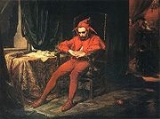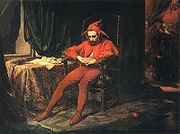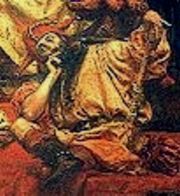
Stanczyk
Encyclopedia

Court jester
A jester, joker, jokester, fool, wit-cracker, prankster, or buffoon was a person employed to tell jokes and provide general entertainment, typically for a European monarch. Jesters are stereotypically thought to have worn brightly colored clothes and eccentric hats in a motley pattern...
in Polish history
History of Poland
The History of Poland is rooted in the arrival of the Slavs, who gave rise to permanent settlement and historic development on Polish lands. During the Piast dynasty Christianity was adopted in 966 and medieval monarchy established...
. He was employed by three Polish
Poland
Poland , officially the Republic of Poland , is a country in Central Europe bordered by Germany to the west; the Czech Republic and Slovakia to the south; Ukraine, Belarus and Lithuania to the east; and the Baltic Sea and Kaliningrad Oblast, a Russian exclave, to the north...
kings: Alexander, Sigismund the Old and Sigismund Augustus.
Name, identity and historicity
Scarcity of sources gave rise to four distinct hypotheses in 19th century: that he was entirely invented by Jan KochanowskiJan Kochanowski
Jan Kochanowski was a Polish Renaissance poet who established poetic patterns that would become integral to Polish literary language.He is commonly regarded as the greatest Polish poet before Adam Mickiewicz, and the greatest Slavic poet, prior to the 19th century.-Life:Kochanowski was born at...
and his colleagues, or that he was "perhaps a typical jester dressed by his contemporaries in an Aesop
Aesop
Aesop was a Greek writer credited with a number of popular fables. Older spellings of his name have included Esop and Isope. Although his existence remains uncertain and no writings by him survive, numerous tales credited to him were gathered across the centuries and in many languages in a...
ian attire, perhaps a Shakespearean vision of 19th century writers, or perhaps indeed a grey eminence
Grey Eminence
Grey Eminence: A Study in Religion and Politics is a book by Aldous Huxley published in 1941. It is a biography of François Leclerc du Tremblay, the French monk who served as advisor to Cardinal de Richelieu. He was also known as Father Joseph and as l'éminence grise; that phrase originally...
of the societatis ioculatorum". In any measure, common consensus among modern scholars is that such a person indeed existed and even if it did not, it had a tremendous importance to Polish culture of later centuries.
Almost nothing is known about Stańczyk's life and even his name and identity are a matter of dispute. Contemporary sources mention court jesters named Gąska and Stańczyk. Notably, both names are featured in two short poems by Jan Kochanowski. Both words are diminutive
Diminutive
In language structure, a diminutive, or diminutive form , is a formation of a word used to convey a slight degree of the root meaning, smallness of the object or quality named, encapsulation, intimacy, or endearment...
s of the words gęś (goose
Goose
The word goose is the English name for a group of waterfowl, belonging to the family Anatidae. This family also includes swans, most of which are larger than true geese, and ducks, which are smaller....
) and Stanisław rather than proper names on their own right. All of the above led Aleksander Brückner
Aleksander Brückner
Aleksander Brückner was a Polish scholar of Slavic languages and literatures , philologist, lexicographer and historian of literature. He is among the most notable Slavicists of the late 19th and early 20th centuries, and the first to prepare complete monographs on the history of Polish language...
and later scholars to believe that Gąska and Stańczyk are merely two nick-names of the same person. Because of that hypothesis Stańczyk is sometimes referred to as Stanisław Gąska, a name that resembles a typical Polish name, except it is of much later provenance and was coined in late 19th century rather than during the jester's times.
In any measure, Stańczyk's fame and legend was strong already in his own times of the Renaissance
Renaissance
The Renaissance was a cultural movement that spanned roughly the 14th to the 17th century, beginning in Italy in the Late Middle Ages and later spreading to the rest of Europe. The term is also used more loosely to refer to the historical era, but since the changes of the Renaissance were not...
, it later reappeared in 19th century and remains well-known to this day. Unlike jesters of other European courts, Stańczyk has been always considered to have been much more than a mere entertainer.
He is remembered as a man of great intelligence and a political philosopher gifted with formidable insight into Poland's current and future situation. He used his job to criticize and warn his contemporaries by the use of satire
Satire
Satire is primarily a literary genre or form, although in practice it can also be found in the graphic and performing arts. In satire, vices, follies, abuses, and shortcomings are held up to ridicule, ideally with the intent of shaming individuals, and society itself, into improvement...
. His witty jokes often pertained to current political or court
Noble court
The court of a monarch, or at some periods an important nobleman, is a term for the extended household and all those who regularly attended on the ruler or central figure...
matters. Stańczyk's remarks and jokes were preserved by numerous contemporary writers and historians, including Łukasz Górnicki, Jan Kochanowski
Jan Kochanowski
Jan Kochanowski was a Polish Renaissance poet who established poetic patterns that would become integral to Polish literary language.He is commonly regarded as the greatest Polish poet before Adam Mickiewicz, and the greatest Slavic poet, prior to the 19th century.-Life:Kochanowski was born at...
, Marcin Kromer
Marcin Kromer
Marcin Kromer or Martin Cromer was Prince-Bishop of Warmia , a cartographer, diplomat and historian in Poland and later in the Polish-Lithuanian Commonwealth...
, and Mikołaj Rej who praised him for fighting hypocrisy in the name of truth. Some sources even go as far as to call him a personal friend to Marcin Kromer
Marcin Kromer
Marcin Kromer or Martin Cromer was Prince-Bishop of Warmia , a cartographer, diplomat and historian in Poland and later in the Polish-Lithuanian Commonwealth...
, to the dislike of the bishops.
The best known anecdote about Stańczyk is that of a hunting incident. In 1533 King Sigismund the Old had a huge bear brought for him from Lithuania
Grand Duchy of Lithuania
The Grand Duchy of Lithuania was a European state from the 12th /13th century until 1569 and then as a constituent part of Polish-Lithuanian Commonwealth until 1791 when Constitution of May 3, 1791 abolished it in favor of unitary state. It was founded by the Lithuanians, one of the polytheistic...
. The bear was released in the forest of Niepołomice near Kraków
Kraków
Kraków also Krakow, or Cracow , is the second largest and one of the oldest cities in Poland. Situated on the Vistula River in the Lesser Poland region, the city dates back to the 7th century. Kraków has traditionally been one of the leading centres of Polish academic, cultural, and artistic life...
so that the king could hunt it. During the hunt, the animal charged at the king, the queen and their courtiers which caused panic and mayhem. Queen Bona
Bona Sforza
Bona Sforza was a member of the powerful Milanese House of Sforza. In 1518, she became the second wife of Sigismund I the Old, the King of Poland and Grand Duke of Lithuania, and became the Queen of Poland and Grand Duchess of Lithuania.She was the third child of Gian Galeazzo Sforza and his wife...
fell from her horse which resulted in her miscarriage. Later, the king criticized Stańczyk for having run away instead of attacking the bear. The jester is said to have replied that "it is a greater folly to let out a bear that was locked in a cage." This remark is often interpreted as an allusion to the king's policy toward Prussia
Prussia
Prussia was a German kingdom and historic state originating out of the Duchy of Prussia and the Margraviate of Brandenburg. For centuries, the House of Hohenzollern ruled Prussia, successfully expanding its size by way of an unusually well-organized and effective army. Prussia shaped the history...
which was defeated by Poland but not fully incorporated into the Crown.
Stańczyk as a symbol


Polish literature
Polish literature is the literary tradition of Poland. Most Polish literature has been written in the Polish language, though other languages, used in Poland over the centuries, have also contributed to Polish literary traditions, including Yiddish, Lithuanian, Ukrainian, Belarusian, German and...
after the partitions
Partitions of Poland
The Partitions of Poland or Partitions of the Polish–Lithuanian Commonwealth took place in the second half of the 18th century and ended the existence of the Polish–Lithuanian Commonwealth, resulting in the elimination of sovereign Poland for 123 years...
(1795). Some writers treated him as a symbol of Poland's struggle for independence, others provided him with rather Shakespearean
William Shakespeare
William Shakespeare was an English poet and playwright, widely regarded as the greatest writer in the English language and the world's pre-eminent dramatist. He is often called England's national poet and the "Bard of Avon"...
traits. He appears in the works of, among others, Julian Ursyn Niemcewicz
Julian Ursyn Niemcewicz
Julian Ursyn Niemcewicz was a Polish poet, playwright and statesman. He was a leading advocate for the Constitution of May 3, 1791.-Life:...
and Józef Ignacy Kraszewski
Józef Ignacy Kraszewski
Józef Ignacy Kraszewski was a Polish writer, historian and journalist who produced more than 200 novels and 150 novellas, short stories, and art reviews He is best known for his epic series on the history of Poland, comprising twenty-nine novels in seventy-nine parts.As a novelist writing about...
.
Teka Stańczyka
In 1869 a group of young conservative publicists: Józef SzujskiJózef Szujski
Józef Szujski was a Polish politician, historian, poet and professor of the Jagiellonian University....
, Stanisław Tarnowski, Stanisław Koźmian and Ludwik Wodzicki, published a series of satirical pamphlets entitled (Stańczyk's Portfolio). Only five years after the tragic end of the January Uprising
January Uprising
The January Uprising was an uprising in the former Polish-Lithuanian Commonwealth against the Russian Empire...
, the pamphlets ridiculed the idea of armed national uprisings and suggested a compromise with Poland's enemies, especially the Austrian Empire
Austrian Empire
The Austrian Empire was a modern era successor empire, which was centered on what is today's Austria and which officially lasted from 1804 to 1867. It was followed by the Empire of Austria-Hungary, whose proclamation was a diplomatic move that elevated Hungary's status within the Austrian Empire...
, and more concentration on economic growth than on political independence. The political faction which adopted these ideas became known as "Stańczycy" (plural of "Stańczyk").
Stańczyk in the arts
Stańczyk was also one of Jan MatejkoJan Matejko
Jan Matejko was a Polish painter known for paintings of notable historical Polish political and military events. His most famous works include oil on canvas paintings like Battle of Grunwald, paintings of numerous other battles and court scenes, and a gallery of Polish kings...
's favorite historical figures and he appears on a number of his paintings, such as in the Prussian Homage
Prussian Homage (painting)
The Prussian Homage is an oil on canvas painting by Polish painter Jan Matejko painted between 1879 and 1882 in Kraków, then part of Austria-Hungary. It depicts a tribute made by Albrecht Hohenzollern, the Duke of Prussia, to King Sigismund I the Old in the Kraków market square on 10 April 1525;...
. Matejko, giving the jester his own facial features, created the popular image of Stańczyk that is familiar to most modern Poles. The painter always depicted Stańczyk with a very concerned and reflective look on his face, in stark contrast to his cap 'n bells and other jester's gear. Matejko's vision of Stańczyk influenced the way other artists, such as Leon Wyczółkowski, later depicted the jester.
The most notable appearance of Stańczyk in literature is in Stanisław Wyspiański's play Wesele (The Wedding)
The Wedding (1901 play)
The Wedding is a defining work of Polish drama written at the turn of the 20th century by Stanisław Wyspiański. It describes the perils of the national drive toward self-determination following the two unsuccessful uprisings against the Partitions of Poland, in November 1830 and January 1863...
where the jester's ghost visits the Journalist, a character modeled after Rudolf Starzewski, editor of the Kraków-based paper Czas (Time), associated with the Stańczycy faction. In the play, Stańczyk accuses the Journalist, who calls the jester a "great man", of inactivity and passive acceptance of the nation's fate. At the end of their conversation, Stańczyk gives the Journalist his "caduceus
Caduceus
The caduceus is the staff carried by Hermes in Greek mythology. The same staff was also borne by heralds in general, for example by Iris, the messenger of Hera. It is a short staff entwined by two serpents, sometimes surmounted by wings...
" (the jester's marotte
Marotte
A Marotte is a prop stick or scepter with a carved head on it. The word is borrowed from the French, where it signifies either a fool's bauble, or a fad/craze....
) and tells him to "stir the nation" but not to "tarnish the sacred things, for sacred they must remain." Thus Wyspiański reinforced Stańczyk's role as a symbol of patriotism and skeptical political wisdom.

